

Data, Data, Everywhere, nor Any Time to Think: DIY Analysis of E-Resource Access Problems: Journal of Electronic Resources Librarianship: Vol 27, No 1. Time for Elsexit? This post is principally addressed to academics in the UK, though some of it may apply to people in other countries too.

The current deal that the universities have with Elsevier expires at the end of this year, and a new one has been negotiated between Elsevier and Jisc Collections, the body tasked with representing the UK universities. If you want, you can read a thoroughly misleading statement about it on Elsevier’s website. On Jisc’s website is a brief news item with a link to further details that tells you almost nothing and then contains a further link entitled “Read the full description here”, which appears to be broken. On the page with that link can be found the statement The ScienceDirect agreement provides access to around 1,850 full text scientific, technical and medical (STM) journals – managed by renowned editors, written by respected authors and read by researchers from around the globe – all available in one place: ScienceDirect.
IEEE Xplore Document - Toward unique identifiers. Abstract: This paper discusses the creation and use of unique identifiers for intellectual property.
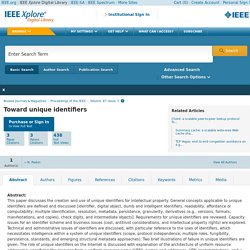
General concepts applicable to unique identifiers are defined and discussed [identifier, digital object, dumb and intelligent identifiers, readability, affordance or computability, multiple identification, resolution, metadata, persistence, granularity, derivatives (e.g., versions, formats, manifestations, and copies), check digits, and intermediate objects].
Requirements for unique identifiers are reviewed. Capacity issues for an identifier scheme and business issues (cost, antitrust considerations, and intellectual property rights) are explored. The E-Resources Management Handbook. Looks like: SESS636698fd811c0f0105518e7332ea5f41 A unique session ID.

This expires when you stop using the site. Finch report executive summary. Finch report final. What is open access? What is open access?
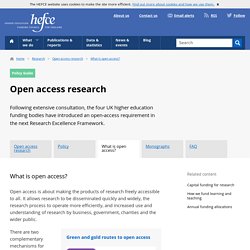
Open access is about making the products of research freely accessible to all. It allows research to be disseminated quickly and widely, the research process to operate more efficiently, and increased use and understanding of research by business, government, charities and the wider public. Green and gold routes to open access There are two complementary mechanisms for achieving open access to research. The first mechanism is for authors to publish in open-access journals that do not receive income through reader subscriptions. The second is for authors to deposit their refereed journal article in an open electronic archive. Open Access Good Practice. Find links to all OA Good Practice Pathfinder blogs here Rationale Given the wide scope and broad impact of research funders’ OA policies, as well as the differing workflows and approaches of HEIs across the sector, examples are needed of effective practice that are collaboratively developed but reflect institutional difference within a ‘real-world’ environment.
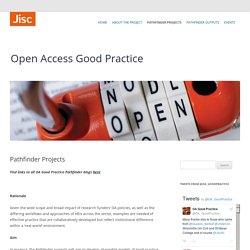
Aim. Article processing charges (APCs) and subscriptions. Executive summary The number of article processing charges (APCs) paid doubled between 2013 and 2014.
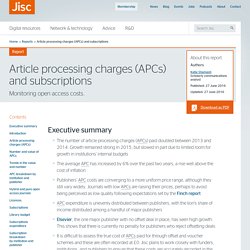
Growth remained strong in 2015, but slowed in part due to limited room for growth in institutions’ internal budgetsThe average APC has increased by 6% over the past two years, a rise well above the cost of inflationPublishers’ APC costs are converging to a more uniform price range, although they still vary widely. Journals with low APCs are raising their prices, perhaps to avoid being perceived as low quality following expectations set by the Finch reportAPC expenditure is unevenly distributed between publishers, with the lion’s share of income distributed among a handful of major publishersElsevier, the one major publisher with no offset deal in place, has seen high growth.
Introduction. The impact of article processing charges for libraries and what we’re doing to help. We’re part way down the road to open access.

Gold open access is becoming an increasingly popular choice for articles, and article processing charges (APCs) are the dominant business model for funding them. The importance of tracking and reporting APCs grows as they become a larger part of the cost of research. Institutions are expected to record APCs to manage payments and plan their budget, and funders use that reporting in order to know how their money is spent and to assess compliance. Good in itself, but APC data becomes even more valuable to the sector as a whole when it is made openly available. Using aggregate data, institutions can assess the value of their APC spend and profile themselves against other institutions.
Home. The benefits of Open Access: Researchers' perspectives. Altmetrics - Introduction from University of Leeds. 2014/07. Executive summary Purpose.
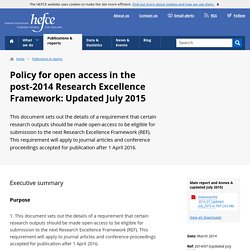
RCUK Policy on Open Access - Research Councils UK. In June 2012 the report from the National Working Group on Expanding Access to Published Research Findings (the ‘Finch Group’) - Accessibility, sustainability, excellence: how to expand access to research publications was published.
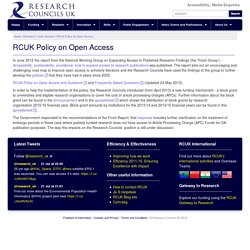
The report sets out an encouraging and challenging road map to improve open access to scholarly literature and the Research Councils have used the findings of the group to further develop the policies that they have had in place since 2005. Why open access should be a key issue for university leaders. Universities are digital machines these days.

Open access is not enough on its own – data must be free too. If your research has been funded by the taxpayer, there's a good chance you'll be encouraged to publish your results on an open access basis – free at point of publication and with reuse and redistribution rights. This final article makes publicly available the hypotheses, interpretations and conclusions of your research. But what about the data that led you to those results and conclusions?
Open Access: An Introduction. By Keith G Jeffery Open Access (OA) means that electronic scholarly articles are available freely at the point of use. The subject has been discussed for over 10 years, but has reached a crescendo of discussion over the last few years with various declarations in favour of OA from groups of researchers or their representatives. The UK House of Commons Science and Technology Committee considered the issue in 2004, reporting in the summer in favour of OA. This indicates the importance of the issue, and led to statements from large research funding bodies such as the Welcome Trust and the Research Councils UK. Open access: six myths to put to rest. Open access to academic research has never been a hotter topic. But it's still held back by myths and misunderstandings repeated by people who should know better. The good news is that open access has been successful enough to attract comment from beyond its circle of pioneers and experts.
The bad news is that a disappointing number of policy-makers, journalists and academics opine in public without doing their homework. How Your Journal Editor Works. W hen I first began submitting work to scholarly journals, I had every sort of outlandish idea about the editor on the other side of the transaction. In hopeful moments, I imagined a kindly bespectacled someone with a jumbo coffee cup at a spotless wooden desk, or holding a glass of wine in an overstuffed chair near a fireplace. This faceless editor would read my essay slowly, nodding approvingly and then more vigorously. "Brilliant! " the editor would say. "Eureka! Most of the time, however, fear prevailed over hope. Today I have fewer illusions, rosy or nightmarish. So I offer here a reality check for those who haven’t (yet) been on both sides: a look into the not-so-glamorous lives and habits of journal editors.
Your scholarly editor is a real person living in real time. Scholarly editors are often happy to share our insights, especially before we have your work in hand. As editors, we are more likely to get a nonresponse or an outright no from a reviewer at academic crunch times.